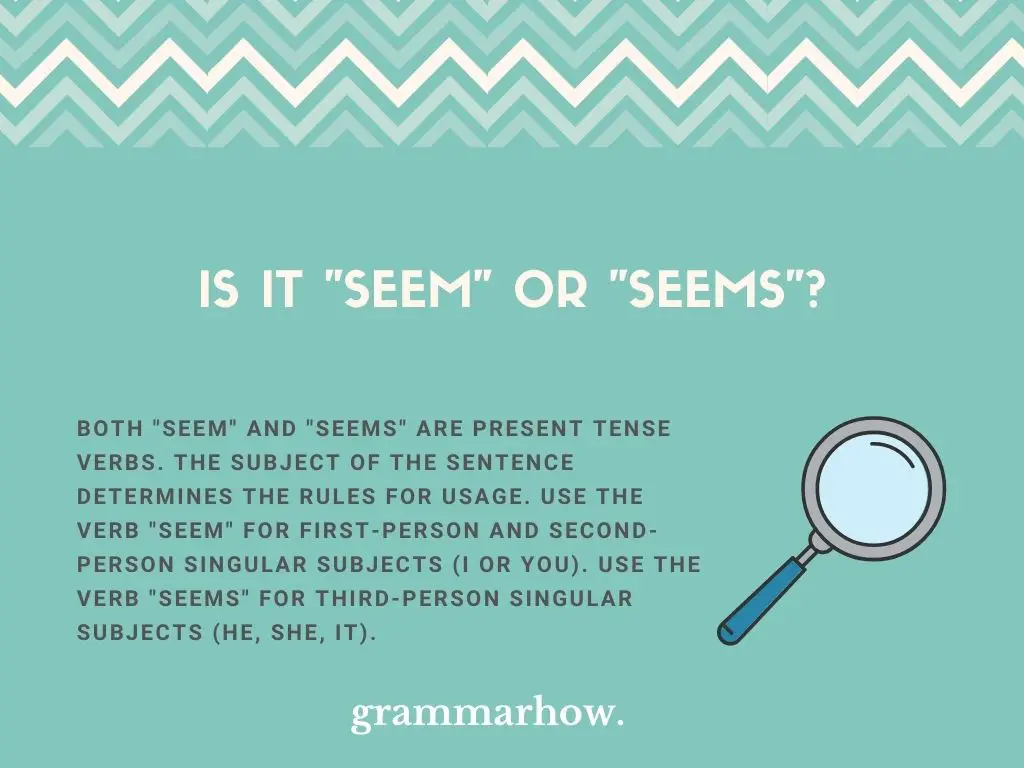It can be challenging to know the correct context to use the verb “seem” or “seems” in a sentence. These two words don’t follow the typical rules for singular and plural verbs. Here we provide an overview of the grammatical rules that you should follow when using “seem” and “seems.”
Is It “Seem” Or “Seems”?
Both “seem” and “seems” are present tense verbs. The subject of the sentence determines the rules for usage. Use the verb “seem” for first-person and second-person singular subjects (I or you). Use the verb “seems” for third-person singular subjects (He, she, it).

The rules of the subject-verb agreement apply here. There are many different subject-verb agreement rules to learn, so it can be complicated to know when to apply them. In this case, the rule that applies is the one that addresses tense and person.
It states that in the present tense, the verbs must agree with their subjects (singular or plural). They must also agree in their person (first, second, or third). You only use the present tense ending of “s” (or “es”) on a verb that has a third-person singular subject. All other subjects do not have the “s” (or “es”) ending.
Is “Seems” The Plural Of “Seem”?
The formation of “seems” is known as a verb inflection and not the plural of “seem.” It is the third-person present tense of the verb “seem.” The word “seem” does not have a plural version. It has an “s” at the end when used with a third-person singular subject.
Third-person singular subjects are the following:
- He
- She
- It
- A person referred to by name (i.e., Mary)
When Should I Use “Seem”?
Use “seem” whenever you have a present tense sentence that does not have a third-person singular subject (he, she, it). Use “seem” in sentences with first-person singular or plural (I, we), second-person singular or plural (you), and third-person plural (they) subjects.
These examples show you how to use “seem” in a sentence.
- You seem to be a nice person, I hope we can be friends.
- I seem to have misplaced the paperwork you sent me.
- They seem to be smarter than we thought.
- I seem to remember meeting you before when we were younger.
- You seem to be angry with me for something.
- We seem to have the same taste in music
- They seem to be ready to leave for the event now.
When Should I Use “Seems”?
Use “seems” in the present tense only when you have a subject that is third-person singular (he, she, it, a name). You should not use it with any other types of subjects. The word “seems” is the third-person present form of the verb “seem.”
Here are several examples that show how to use “seems” in a sentence.
- Mark seems to have forgotten that we had a meeting at 2:00.
- He seems to be quite familiar to me.
- She seems to be a kind person, but she’s very shy.
- It seems like only yesterday I met you.
- It seems like it’s gearing up to be a long day.
- Linda seems to remember who you are.
- He seems to be upset about something today.
Is It “There Seem” Or “There Seems”?
Both “there seem” and “there seems” are correct. It depends on whether the thing that “seems” is a singular thing or a plural thing. If the subject is singular, use the word “there seems.” If the subject is plural, use “there seem.”
Here are examples that show “there seem” and “there seems” used in a sentence.
- There seem to be way too many people here tonight.
- There seems to be a good reason why he couldn’t make it to the party.
Is It “People Seem” Or “People Seems”?
The correct phrase to use is “people seem.” The phrase “people seems” is incorrect. The reason for this is that the word “people,” although third-person, is plural. Therefore, it does not use the third-person singular version of the verb “seems.” It uses the third-person plural form of “seem.”
Here are two examples that show how to use “people seem” in a sentence.
- People seem to really like that restaurant a lot.
- People seem to like talking to him a lot. He’s very interesting.
You may also like:
“It Seems” vs. “It Seems That” – Difference Explained
“Seems Like” Meaning & Synonyms (10 Helpful Examples)
“Seems To Be” Meaning (And When It Is Used Instead Of “Seems”)

Martin holds a Master’s degree in Finance and International Business. He has six years of experience in professional communication with clients, executives, and colleagues. Furthermore, he has teaching experience from Aarhus University. Martin has been featured as an expert in communication and teaching on Forbes and Shopify. Read more about Martin here.
